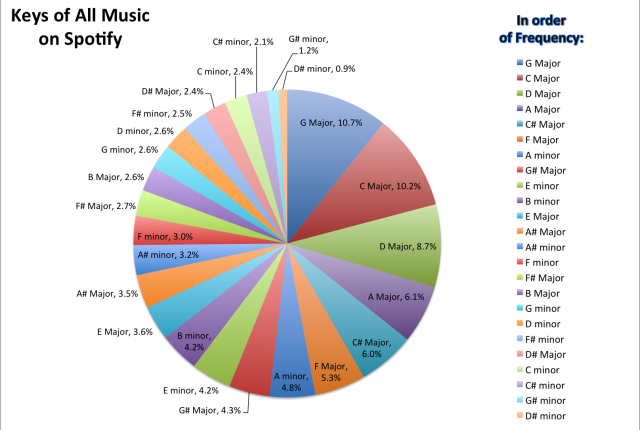
Posted by Mike McCready | May 7th, 2015 | No responses
Guest Post by Eliot Van Buskirk on Spotify Insights
Unless you count the microtones between what the notes in the genres many of us are most familiar with, there are only 12 notes in all of music.
That’s over 30 million songs, the vast majority with various combinations of the same 12 notes. In addition, every song in western music is based around only one of these notes, as well as a mode — almost always major, which sounds happy, or minor, which does not. These two elements determine what key a given piece of music is in, and are known as the “key” of the song.
Spotify data analyst and jazz pianist Kenny Ning took it upon himself to analyze the key of every track on Spotify, to determine how frequently they appear, and we turned the result into a chart.
“With regard to Western contemporary music (which dominates our catalog), instrumentation is largely based around guitar, piano, or both,” said Ning. “So, the hypothesis here is that the key signature should be a convenient key for both guitar and piano.”
Let’s find out:
More mysterious, at first glance anyway, is the order of the notes. Why is G Major the top key on all of Spotify? And why is C Major number two?
Much like electricity going through a circuit, songwriters often take the path of least resistance. On a keyboard or a guitar — both incredibly popular instruments for composing western music — that path is through G Major.
We saw a similar phenomenon with minor keys. A minor, the relative minor of C major, is the easiest minor to play on a keyboard. It’s the also the most popular minor key, with 4.8 percent of all the music on Spotify.
Kenny Ning explains:
“E is convenient for guitar, but not piano.
C is convenient for piano, but not guitar.
G is convenient for both guitar and piano.
So, why is G major the most popular key signature in Spotify’s catalog? It’s likely because most popular Western contemporary music instruments are biased towards certain keys.
When people talk about the ‘key signature’ or ‘key’ of a song, they are referring to the tonal center of the song. The key signature will also determine what notes and chords your song should use if you want it to sound consonant/pleasant.
The guitar and the piano are probably the two most popular instruments in modern Western music history. So I would assume a lot of composition today begins on one of those two instruments. And for those who have ever studied guitar or piano, they quickly learn that certain keys are easier to play than others.
Black keys on a piano are thin and somewhat hard to strike accurately, and the player/composer has to remember where they are. Thus pianists will stick to key signatures that are largely composed of white keys, such as C major, G major, or F major.
For guitar, there are certain chords that are naturally easy to play given the standard tuning of the strings. There’s a reason the first chords you learn in guitar are E major, G major, A major, and D major.
Combine these two sets of ‘easy to play’ keys together, and you’ll see that G is the common denominator between guitar and piano. So it’s no surprise that songwriters would write their chords in these keys so they could focus their energy on more important things… melody and lyrics.”